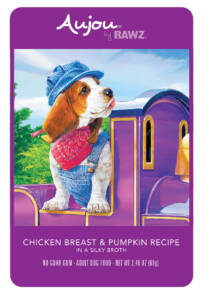Common Dog Stomach Issues and Digestive Problems

If you’re an experienced dog parent, you likely have a catalog of warning signs that your pet is having stomach issues. Whether your dog is spending more time in a certain area of the house or they’re giving you a distinct “look,” many of us have an almost sixth sense when it comes to our dog’s digestion! This blog will take a look at some common dog stomach issues and digestive problems, so you know what might be troubling them next time they give you that look.
Common Causes
The first step in addressing any digestive issue in your dog is to determine the cause. Generally, stomach issues are caused by:
- Improperly ingested food
- Allergies or hypersensitivity
- Parasites
- Viral infection
- Harmful bacteria such as Salmonella
- Diseases of the liver, pancreas, adrenal glands, prostate or kidneys
Dogs’ gastrointestinal tracts become conditioned to their standard diet, so a dog will have increased sensitivity to changes in feeding, whether that’s the time of feeding or the food itself.
How to Tell if Your Dog Has Digestive Issues [Common Symptoms]
Although not all canine digestive issues present obvious symptoms, diarrhea, constipation, bloat or just unusual behavior or energy levels are the main signs.
- While most dog owners are familiar with the loose, watery and/or more frequent stools that signal diarrhea, bloat and constipation can be less recognizable.
- Dogs typically pass one or two stools a day, so a reduction in frequency or volume of waste may indicate constipation.
- Bloating is when a dog’s stomach becomes stretched when filled with gas, food or fluid. While bloating can simply cause discomfort, the stomach can twist in a serious and potentially fatal condition known as gastric dilatation-volvulus (GDV). Owners of middle-aged dogs should be aware of the warning signs of GDV, which include pacing, excessive drooling and general distress, and call their veterinarian's emergency line immediately.
Causes of Diarrhea in Dogs
Diarrhea can occur in dogs for many reasons, but the most common causes are:
- Abrupt changes in diet
- Ingestion of non-food items
- Food allergies and sensitivities
- Stress
- Parasites
- Viral or bacterial infections
- Underlying illness or disease
- Side effects of medication
If you notice your dog experiencing diarrhea, a visit to your veterinarian will help determine if the cause is more serious than a poorly digested piece of garbage. Additional symptoms that may indicate a more serious condition requiring veterinary intervention can include weakness, fever, vomiting or loss of appetite.
Symptoms that Require Immediate Vet Attention
Whenever a dog is known to have ingested something harmful — an allergen, plant, toy, plastics or chemicals — immediate veterinarian attention should be sought. Otherwise, at the first sign of a stomach issue, it is best to monitor your dog for changes in display or severity of symptoms. Increasing discomfort or sudden collapse indicate professional consultation is needed. More than two instances of vomiting or diarrhea, a foreign or unusual object and/or blood in vomit/stool also signify it’s time to call the vet. The ASPCA also provides a poison control hotline that pet owners can access for a fee.
Medical intervention for stomach issues can include anti-nausea medication, antibiotics or, in the most extreme cases, surgery to remove a foreign object or treat GVD.
How to Treat Dog Digestive Issues at Home
It is very important to rule out any serious health issues before attempting to treat your dog’s digestive experiences at home. If your dog’s symptoms don’t indicate an emergency, here are three commonly used home remedies:
Fasting: Withholding all food for 12–24 hours will help your dog clear his or her digestive tract of any food and provide a reset of sorts.
Ice cubes: Ice provides hydration and can limit hunger pains while fasting.
100% canned pumpkin: Pumpkin’s low glycemic index results in slow absorption, which can aid in digestion. Be sure to use plain canned pumpkin instead of pumpkin pie filling, which is full of sugar and spices.
How to Monitor Your Pet When They Experience Digestive Discomfort
Diarrhea and vomiting are tell-tale signs of digestive problems, but a few other behaviors can be indicative. Visual or auditory signs of digestive distress can include:
- Restlessness OR lethargy
- Flatulence
- Excessive licking (a self-soothing behavior)
- Excessive drooling or swallowing
- Frequent turning or looking toward the flanks
- Non-productive retching
- Vomiting OR diarrhea
- Frequently assuming the “praying” or “downward dog” position
- Audible rumbling or gurgling from the stomach
Keep a close watch for these signs and take note of isolating behavior.
While RAWZ cannot diagnose canine stomach issues, we have found that incorporating minimally processed, moisture-rich foods into our pets’ diets can ease the symptoms of dehydration or ingesting too many filler ingredients that are devoid of nutrition. If you’re curious about whether a diet change will ease your pet’s stomach discomfort, consult with your veterinarian, then explore our options for both dogs and cats. We are 100% committed to providing your pet with the best in delicious, nutritious meals!
FAQs
Q. How do I transition my dog to a new food while minimizing digestion distress?
A. Since our pets typically eat from a consistent menu, most dogs’ GI systems become hyper-conditioned to their regular food and can be very sensitive to dietary alterations. Because of this, it is always best to gradually transition your dog to a new food. Generally, a 5–7 day transition period works well, keeping in mind that all pets will adapt at different speeds, especially when transitioning from a highly processed diet to less processed meals.
Q. Does my dog have a food allergy or food sensitivities?
A. Any talk of stomach issues tends to generate questions about food allergies or sensitivities. But what are they and what’s the difference between the two?
While both food allergies and sensitivities result in similar presenting symptoms — many resembling the common symptoms mentioned in our discussion above — there is one distinct factor separating them. In the case of an allergy, the offending ingredient (generally an animal protein) triggers an immune response. Although often symptomatically similar, a sensitivity describes an unusual response not involving the immune system, such as an inability to process certain ingredients. An animal nutritionist can help you determine which foods may not be compatible with your dog’s system.








